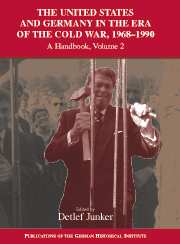Book contents
- Frontmatter
- POLITICS: Détente and Multipolarity: The Cold War and German-American Relations, 1968-1990
- 1 The United States and the German Question
- 2 The Federal Republic of Germany Between the American and Russian Superpowers - “Old Friend” and “New Partner”
- 3 Ostpolitik: Détente German-Style and Adapting to America
- 4 Creative Tension: The United States and the Federal Republic in the CSCE
- 5 The United States, Germany, and the Multilateralization of International Relations
- 6 Expectations of Dominance and Partnership Rhetoric: The Federal Republic of Germany in the Crossfire of American and French Policy, 1945-1990
- 7 West Germany and European Unity in U.S. Foreign Policy
- 8 Cooperation and Conflict in German and American Policies toward Regions Outside Europe
- 9 Two States, One Nation: The International Legal Basis of German-American Relations from Ostpolitik to Unification
- 10 The U.S. Congress and German-American Relations
- 11 The German Political Parties and the USA
- 12 The Role of East Germany in American Policy
- 13 The United States and German Unification
- SECURITY: German-American Security Relations, 1968-1990
- ECONOMICS: Cooperation, Competition, and Conflict: Economic Relations Between the United States and Germany, 1968-1990
- CULTURE: Culture as an Arena of Transatlantic Conflict
- SOCIETY: German-American Societal Relations in Three Dimensions, 1968-1990
- 1 “1968”: A Transatlantic Event and Its Consequences
- OUTLOOK: America, Germany, and the Atlantic Community After the Cold War
- Index
5 - The United States, Germany, and the Multilateralization of International Relations
Published online by Cambridge University Press: 05 January 2013
- Frontmatter
- POLITICS: Détente and Multipolarity: The Cold War and German-American Relations, 1968-1990
- 1 The United States and the German Question
- 2 The Federal Republic of Germany Between the American and Russian Superpowers - “Old Friend” and “New Partner”
- 3 Ostpolitik: Détente German-Style and Adapting to America
- 4 Creative Tension: The United States and the Federal Republic in the CSCE
- 5 The United States, Germany, and the Multilateralization of International Relations
- 6 Expectations of Dominance and Partnership Rhetoric: The Federal Republic of Germany in the Crossfire of American and French Policy, 1945-1990
- 7 West Germany and European Unity in U.S. Foreign Policy
- 8 Cooperation and Conflict in German and American Policies toward Regions Outside Europe
- 9 Two States, One Nation: The International Legal Basis of German-American Relations from Ostpolitik to Unification
- 10 The U.S. Congress and German-American Relations
- 11 The German Political Parties and the USA
- 12 The Role of East Germany in American Policy
- 13 The United States and German Unification
- SECURITY: German-American Security Relations, 1968-1990
- ECONOMICS: Cooperation, Competition, and Conflict: Economic Relations Between the United States and Germany, 1968-1990
- CULTURE: Culture as an Arena of Transatlantic Conflict
- SOCIETY: German-American Societal Relations in Three Dimensions, 1968-1990
- 1 “1968”: A Transatlantic Event and Its Consequences
- OUTLOOK: America, Germany, and the Atlantic Community After the Cold War
- Index
Summary
In its simplest form, multilateralism is a method of diplomacy that considers diplomatic partners several at a time. Bilateralism, by contrast, deals with other countries one by one. Multilateralism can be formal, involving treaty organizations and other multinational institutions; it can also be informal, based simply on an appreciation of how particular events affect several nations simultaneously. In practice the formal and informal entwine; a network of explicit commitments and implicit understandings knit together the participating nations and constrain their actions.
Relations between the United States and Germany since World War II provide a good example of the formal and informal aspects of multilateralism. Formal elements took precedence first, but as the memories of the war faded and the two sides gained confidence in each other, informal multilateralism grew more important. At the same time, the purposes of multilateralism for the two governments changed along with the relative strength of the military, political, economic, and cultural aspects of their relationship. For Washington, multilateralism was initially a method of tying Germany down and binding Bonn to the West; later it became a way of encouraging the Germans to contribute to European security. For Bonn, multilateralism at first served as an alternative to indefinite occupation; later it became an avenue for Germany's reemergence as the leading power in Europe.
- Type
- Chapter
- Information
- The United States and Germany in the Era of the Cold War, 1945–1990A Handbook, pp. 47 - 53Publisher: Cambridge University PressPrint publication year: 2004

